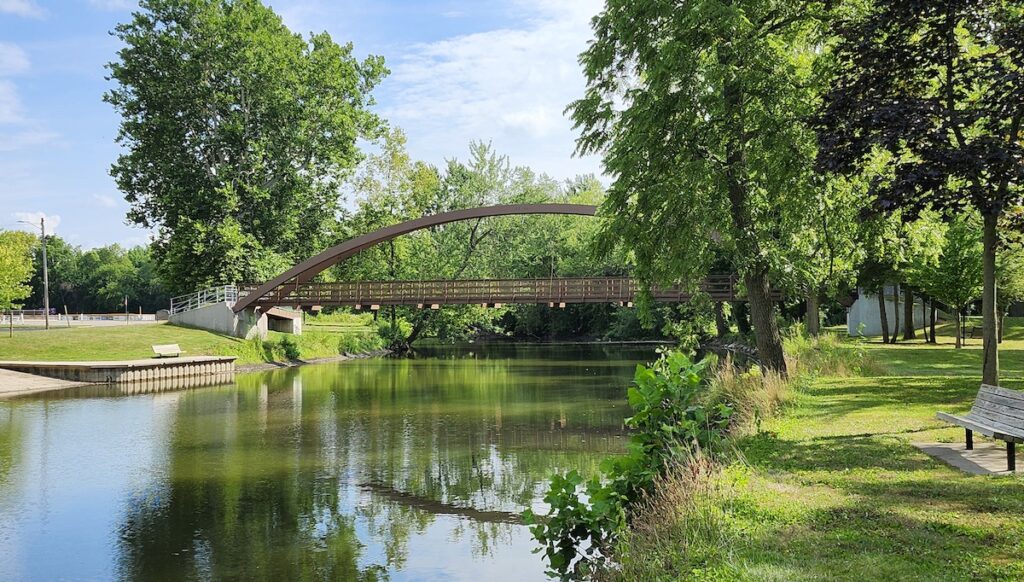
ADRIAN — A new report card, issued by the University of Maryland Center for Environmental Science in collaboration with the River Raisin Watershed Council and several other partners, provides new clarity on the health of the River Raisin and its watershed.
Meija Knafl, outreach coordinator for the nonprofit River Raisin Watershed Council, said the Center for Environmental Science first started developing watershed report cards to study the health of the Chesapeake Bay area, then began expanding its efforts by applying the model to other environmentally important watersheds. The River Raisin effort was part of a project, funded by the Fred A. and Barbara M. Erb Family Foundation, that studied all five watersheds that feed into the western Lake Erie basin: the River Raisin, the Detroit River, the Clinton River, the Huron River, and the River Rouge.
Those watersheds are of high interest in part because of the problems Lake Erie has with toxic algae blooms.
“Lake Erie is the shallowest of the Great Lakes and it’s what we call the most biologically productive as well,” Knafl said.
Being biologically productive may sound like it would always be a good thing, but it’s more complex than that. Because the lake is shallow, light is able to penetrate better, which can lead to excessive plant and bacterial growth, including the algae blooms that have closed numerous beaches and caused headaches for the many communities that rely on Lake Erie for safe drinking water.
The report card looked at six main topics — water quality, recreation, infrastructure, human health, the ecosystem, and the economy.
Water quality: Overall, the River Raisin scored a “C-minus” on the report card, meaning it is in moderate condition.
One major piece of good news for the River Raisin’s water quality is its dissolved oxygen level, which scored an “A” on the report card. Dissolved oxygen is necessary for fish and other organisms to thrive, Knafl said, and a lack of dissolved oxygen can create “dead zones” and lead to fish die-offs.
However, a major area of concern is the river’s nitrogen level, which scored an “F.” Nitrogen is one of the main factors contributing to algae blooms.
Interestingly, Knafl said, people often think of agricultural runoff when they think of excessive nitrogen, but “in general we’re finding that nitrogen can be put in the water in a lot of different ways.”
People fertilizing their lawns can also be a major source of nitrogen runoff, she said, adding that farmers who engage in good conservation practices are among the River Raisin Watershed Council’s most important allies in protecting the river.
Phosphorous levels were listed as moderately healthy. Knafl noted that state law bans the use of phosphorous in residential and commercial fertilizers.
One piece of advice the River Raisin Watershed Council gives to lakefront property owners, she added, is to fertilize their lawns using lake water. This takes advantage of the nutrients already present in the lakes and avoids contributing to excessive nutrients that cause problems.
Water temperature was another area where the River Raisin received a moderate grade on the report card. Water that gets too warm can experience excessive plant growth, leading to fish die-offs.
The River Raisin scored poorly on water turbidity. Turbidity is a measure of how much sediment is in the water column, and more turbidity can lead to harmful materials — that otherwise might remain trapped in sediment — being released. As an example of this, Knafl said, the strategy that has been used in the Monroe area to keep PCBs from industrial pollution out of the water is to cover them with a layer of concrete.
Recreation: The River Raisin watershed scored a “B” on recreation. Among other things, this measure looked at how much public access to fishing was available, as well as other recreational activities along the river.
Infrastructure: This measure looked at things like the number of sewer overflows in the region and the percentage of the watershed that’s covered with impervious surfaces. The River Raisin watershed scored a “B.”
Human health: Factors looked at here included presence of bacteria, which was the area of most concern, and air quality, which was where the River Raisin watershed scored the best. The overall assessment of human health in the watershed was a “C-minus.”
Ecosystem: This measure looked at everything from bird diversity to how many protected lands are in the watershed, and the overall score was a “C.”
Economy: The economic health of the watershed area also received a “C” ranking.
Click here to read the entire report card.

